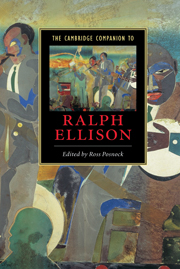Book contents
- Frontmatter
- Introduction
- 1 Ralph Ellison’s invented life
- 2 Ellison and the black Church
- 3 Ellison, photography, and the origins of invisibility
- 4 Ralph Ellison’s music lessons
- 5 Ralph Ellison’s constitutional faith
- 6 Ralph Ellison and the politics of melancholia
- 7 Invisible Ellison
- 8 Ellison’s experimental attitude and the technologies of illumination
- 9 Female iconography in Invisible Man
- 10 Chaos not quite controlled
- 11 Ralph Ellison, Hannah Arendt, and the meaning of politics
- 12 Dry bones
- Selected bibliography and suggestions for further reading
- Index
- Series List
6 - Ralph Ellison and the politics of melancholia
Published online by Cambridge University Press: 28 May 2006
- Frontmatter
- Introduction
- 1 Ralph Ellison’s invented life
- 2 Ellison and the black Church
- 3 Ellison, photography, and the origins of invisibility
- 4 Ralph Ellison’s music lessons
- 5 Ralph Ellison’s constitutional faith
- 6 Ralph Ellison and the politics of melancholia
- 7 Invisible Ellison
- 8 Ellison’s experimental attitude and the technologies of illumination
- 9 Female iconography in Invisible Man
- 10 Chaos not quite controlled
- 11 Ralph Ellison, Hannah Arendt, and the meaning of politics
- 12 Dry bones
- Selected bibliography and suggestions for further reading
- Index
- Series List
Summary
In the Prologue to Ralph Ellison's Invisible Man, the narrator explicates the novel's central metaphor by telling us that he is invisible because ''[white] people refuse to see [him].'' The narrator proceeds to illustrate this assertion with a story about a violent confrontation that took place between himself and a white man:
One night I accidentally bumped into a man . . . he looked insolently out of his blue eyes and cursed me . . . I yelled, ''Apologize! Apologize!'' But he continued to curse and struggle, and I butted him again and again until he went down heavily . . . I kicked him profusely . . . when it occurred to me that the man had not seen me, actually; that he, as far as he knew, was walking in midst of a walking nightmare . . . a man almost killed by a phantom. (4)
This passage offers a striking yet enigmatic vision of the nature of racial blindness. Seemingly explicit, the description nonetheless opens up layers of complicated questions about the differences between perception and projection, between action and reaction, in a racial encounter. From the narrator’s perspective, we see the white man’s ‘‘insolence’’ as anger from having to confront what he presumably did not want to see.
- Type
- Chapter
- Information
- The Cambridge Companion to Ralph Ellison , pp. 121 - 136Publisher: Cambridge University PressPrint publication year: 2005
- 10
- Cited by



